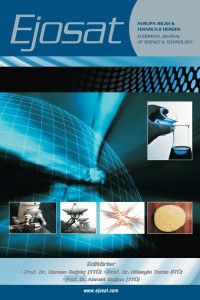Determination of optimum insulation thickness and energy saving analysis according to heating and cooling loads for exterior walls of a house in Malatya
Abstract
Growing population and developing technology continuously increases the demand for energy. One of the most effective methods for energy saving in buildings is thermal insulation. In this study, the optimum insulation thickness, total cost, energy saving and reimbursement period for Malatya city were calculated for two different wall structures (externally insulated walls and sandwich walls), three different types of fuel (natural gas, coal and electricity) and two different insulation materials (extruded polystyrene (XPS), expanded polystyrene (EPS)) for only heating, only cooling and both heating and cooling conditions. According to the results, the optimum insulation thicknesses is between 0.0549 m and 0.0836 m, the energy savings is between 24.79 TL/m2 and 60.45 TL/m2 and payback period is between 2.5714 and 4.2062 years for both heating and cooling conditions.
References
- Ogulata, R.G. (2002). Sectoral energy consuption in Turkey. Renewable and Sustainable Energy Rewies: 6, 471-480.
- Kaygusuz K., Kaygusuz A. (2004). Energy and sustainabledevelopment. Part II: Environmental inpacts of energy use. Energy Sources: 26, 1071-1082.
- Çomaklı, K., Yüksel, B. (2003). Optimum Insulation Thickness of Extermal Walls for Energy Saving. Applied Thermal Engineering: 23,473-479.
- Bolatturk, A. (2003). Binalarda Optimım Yalıtım Kalınlıklarının Hesabı ve Enerji Tasarrufundaki Rolü. 14. Ulusal Isı Bilimi ve Tekniği Kongresi, 41-47.
- Kurekci, N.A. (2016). Determination of optimum insulation thickness for building walls by using heating and cooling degree-day values of all Turkey’s provincial centers. Energy and Building.: 118, 197–213.
- Nematchoua, M.K., Ricciardi, P., Reiter, S., Yvon, A. (2017). A comparative study on optimum insulation thickness of walls and energy savings in equatorial and tropical climate. International Journal of Sustainable Built Environment: 6, 170-182.
- Evin, D., Ucar A. (2019). Energy impact and eco-efficiency of the envelope insulation in residential buildings in Turkey. Applied Thermal Engineering: 154, 573–584.
- Aktemur, C., Atikol, U. (2017). Optimum Insulation Thickness for the Exterior Walls of Buildings in Turkey Based on Different Materials. Energy Sources and Climate Regions, International Journal of Engineering Technologies-IJET: 3, 72-82.
- Kaynaklı, O. (2008). A Study on Residential Heating Energy Requirement and Optimum Insulation Thickness. Renewable Energy: 33, 1164-1172.
- Dombayci, Ö. A., Atalay, Ö., Acar, Ş. G., Ulu, E. Y., Ozturk, H.K. (2017). Thermoeconomic method for determination of optimum insulation thickness of external walls for the houses: Case study for Turkey. Sustainable Energy Technologies and Assessments: 22, 1-8.
- Canbolat, A. S., Bademlioglu, A. H., Kaynakli, O. (2018). Determination of proper insulation thickness for building walls regarding economic consideration. International Research Journal of Advanced Engineering and Science: 3, 173-176.
Bir Konutun Dış Duvarları İçin Isıtma ve Soğutma Yüklerine Göre Optimum Yalıtım Kalınlığın Tespiti ve Enerji Tasarrufu Analizi
Abstract
Artan nüfus,
gelişen teknoloji enerjiye olan talebi sürekli olarak artırmaktadır. Bu durum
Türkiye gibi gelişmekte olan ülkeleri zorunlu enerji tasarrufuna yöneltmiştir.
Yapılarda enerji tasarrufu için kullanılan en etkin yöntemlerden biri ısı
yalıtımıdır. Bu çalışmada iki farklı duvar modeli (dıştan yalıtımlı duvar ve
sandviç duvar), üç farklı yakıt çeşidi (doğalgaz, kömür ve elektrik) ve iki
farklı yalıtım malzemesi sıkıştırılmış polistiren (XPS) ve genleştirilmiş
polistiren (EPS) kullanılarak yalnız ısıtma, yalnız soğutma ve hem ısıtma hem
de soğutma durumunda Malatya ili için optimum yalıtım kalınlığı, toplam
maliyet, enerji tasarrufu ve geri ödeme süresi hesaplanmıştır. Elde edilen
sonuçlardan, hem ısıtma ve hem de soğutma durumu için optimum yalıtım
kalınlıkları 0.0549 m ile 0.0836 m arasında, enerji tasarrufları 24.79 TL/m2
ile 60.45 TL/m2 arasında ve geri ödeme sürelerinin ise 2.5714 ve
4.2062 yıl arasında değiştiği gözlemlenmiştir.
References
- Ogulata, R.G. (2002). Sectoral energy consuption in Turkey. Renewable and Sustainable Energy Rewies: 6, 471-480.
- Kaygusuz K., Kaygusuz A. (2004). Energy and sustainabledevelopment. Part II: Environmental inpacts of energy use. Energy Sources: 26, 1071-1082.
- Çomaklı, K., Yüksel, B. (2003). Optimum Insulation Thickness of Extermal Walls for Energy Saving. Applied Thermal Engineering: 23,473-479.
- Bolatturk, A. (2003). Binalarda Optimım Yalıtım Kalınlıklarının Hesabı ve Enerji Tasarrufundaki Rolü. 14. Ulusal Isı Bilimi ve Tekniği Kongresi, 41-47.
- Kurekci, N.A. (2016). Determination of optimum insulation thickness for building walls by using heating and cooling degree-day values of all Turkey’s provincial centers. Energy and Building.: 118, 197–213.
- Nematchoua, M.K., Ricciardi, P., Reiter, S., Yvon, A. (2017). A comparative study on optimum insulation thickness of walls and energy savings in equatorial and tropical climate. International Journal of Sustainable Built Environment: 6, 170-182.
- Evin, D., Ucar A. (2019). Energy impact and eco-efficiency of the envelope insulation in residential buildings in Turkey. Applied Thermal Engineering: 154, 573–584.
- Aktemur, C., Atikol, U. (2017). Optimum Insulation Thickness for the Exterior Walls of Buildings in Turkey Based on Different Materials. Energy Sources and Climate Regions, International Journal of Engineering Technologies-IJET: 3, 72-82.
- Kaynaklı, O. (2008). A Study on Residential Heating Energy Requirement and Optimum Insulation Thickness. Renewable Energy: 33, 1164-1172.
- Dombayci, Ö. A., Atalay, Ö., Acar, Ş. G., Ulu, E. Y., Ozturk, H.K. (2017). Thermoeconomic method for determination of optimum insulation thickness of external walls for the houses: Case study for Turkey. Sustainable Energy Technologies and Assessments: 22, 1-8.
- Canbolat, A. S., Bademlioglu, A. H., Kaynakli, O. (2018). Determination of proper insulation thickness for building walls regarding economic consideration. International Research Journal of Advanced Engineering and Science: 3, 173-176.
Details
| Primary Language | Turkish |
|---|---|
| Subjects | Engineering |
| Journal Section | Articles |
| Authors | |
| Publication Date | August 31, 2019 |
| Published in Issue | Year 2019 Issue: 16 |

